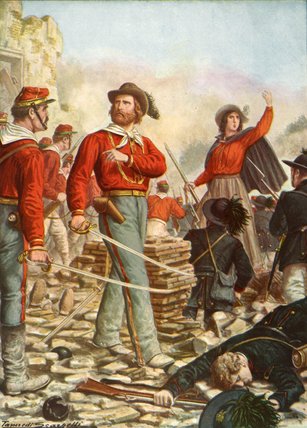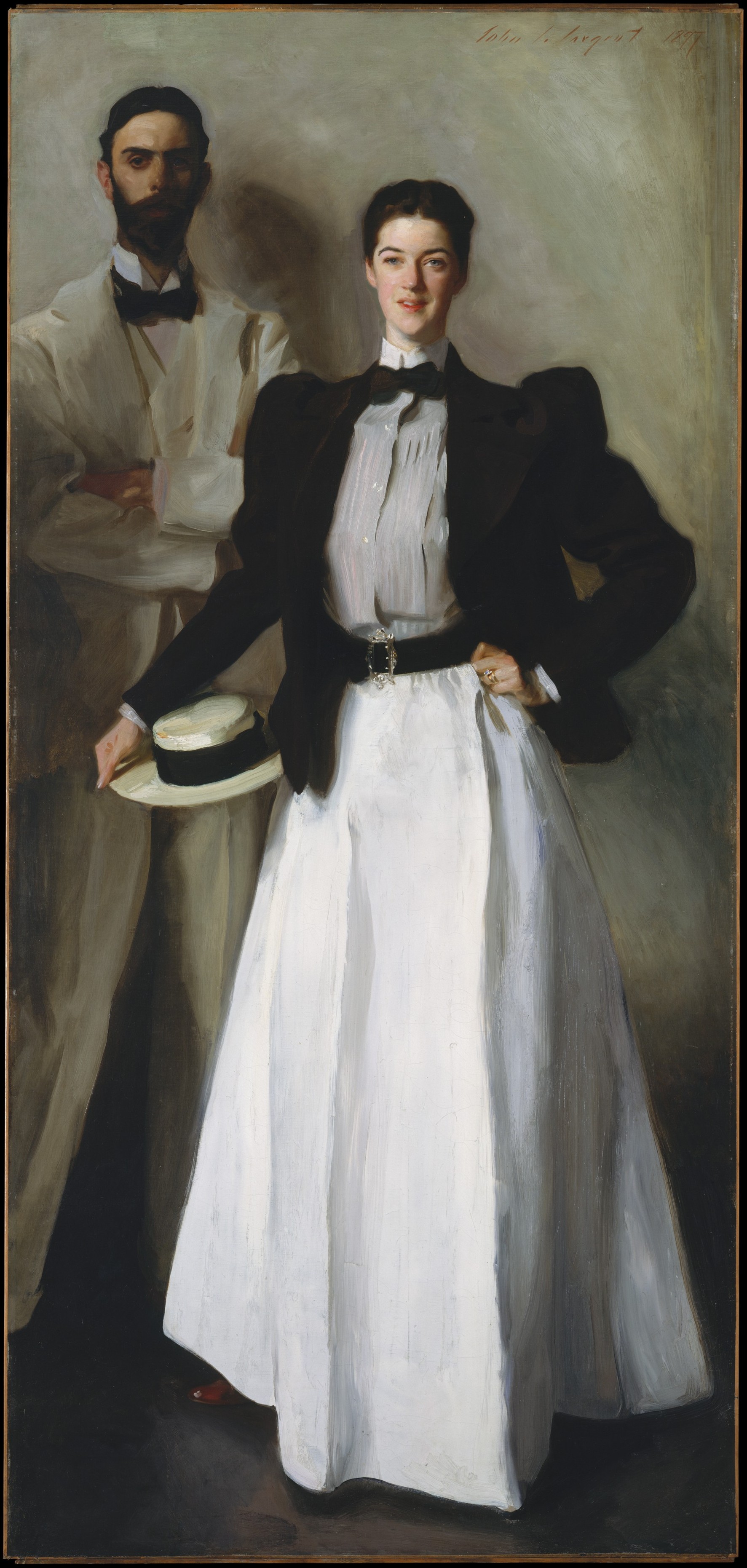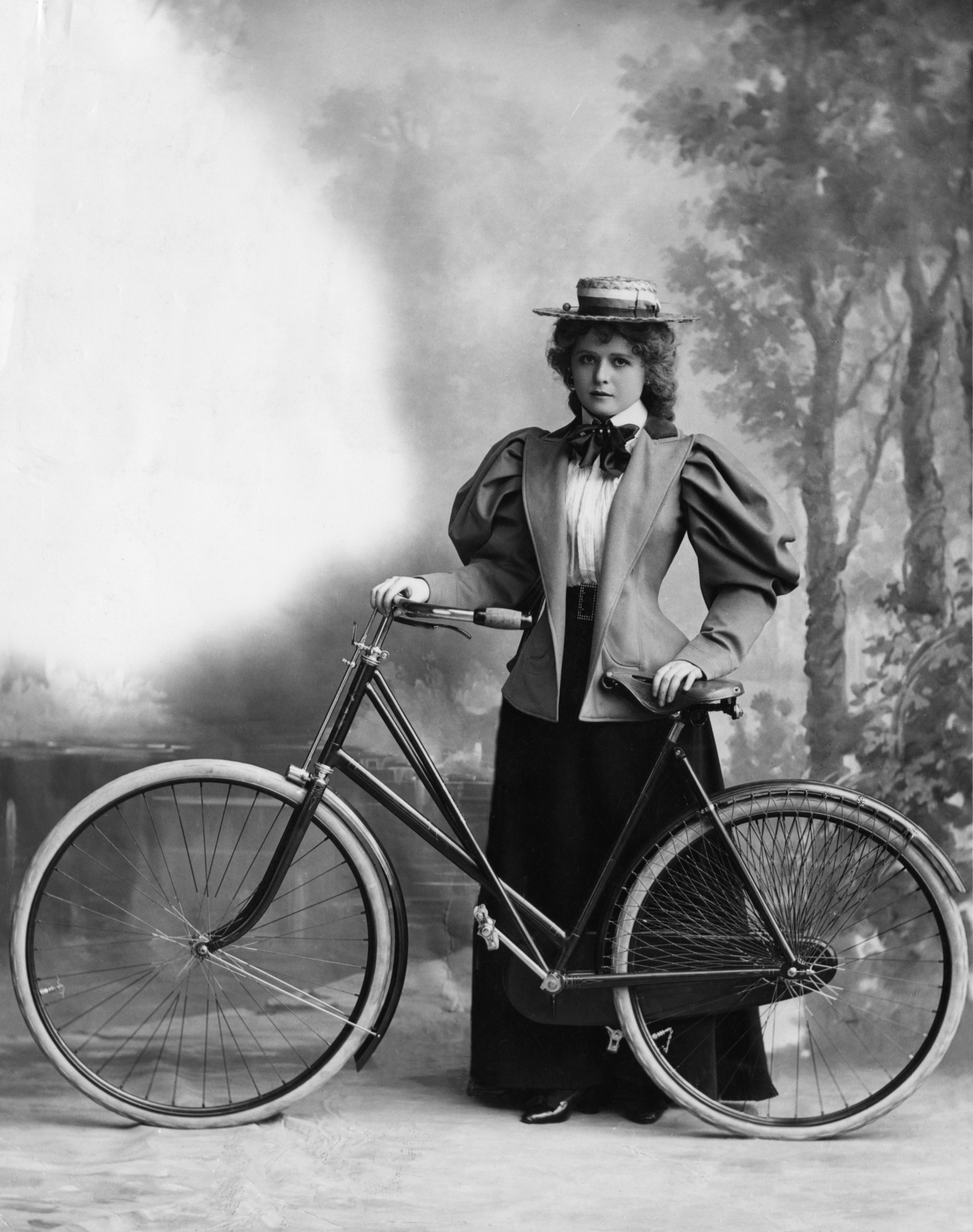|
Blouse
A blouse (blau̇s, 'blau̇z, ) is a loose-fitting upper garment that was worn by workmen, peasants, artists, women, and children.The Concise Oxford English Dictionary It is typically gathered at the waist or hips (by tight hem, pleats, parter, or belt) so that it hangs loosely ("blouses") over the wearer's body. Today, the word most commonly refers to a girl's or woman's dress shirt. It can also refer to a man's shirt if it is a loose-fitting style (e.g. poet shirts and Cossack shirts), though it rarely is. Traditionally, the term has been used to refer to a shirt which blouses out or has an unmistakably feminine appearance. The term is also used for some men's military uniform jackets. Etymology Blouse is a loanword from French to English (see Wiktionary entry ). Originally referring to the blue blouse worn by French workmen, the term "blouse" began to be applied to the various smocks and tunics worn by English farm labourers. In 1870, blouse was first referenced as being ... [...More Info...] [...Related Items...] OR: [Wikipedia] [Google] [Baidu] |
Poet Shirt
A poet shirt (also known as a poet blouse or pirate shirt) is a type of shirt made as a loose-fitting blouse with full bishop sleeves, usually decorated with large frills on the front and on the cuffs. Typically, it has a laced-up V-neck opening, designed to pull over the head, but can have a full-length opening fastened by buttons. The collar may be standing or folded over with points. Fabrics commonly used in its manufacture include linen, cotton, satin and velvet, while frills may be of the same fabric or of lace. Originally intended as a male garment, it is also worn by women today (though still interchangeably referred to as both a "shirt" and a "blouse" regardless of which gender is wearing it). History Although descended from the shirts worn by men in the 17th and 18th centuries, the modern poet blouse combines two aspects: the fineness of ruffled shirts worn as an undergarment by aristocrats and the informality of plain shirts worn (normally open-necked) as a standal ... [...More Info...] [...Related Items...] OR: [Wikipedia] [Google] [Baidu] |
Garibaldi Shirt
A Garibaldi shirt (also called "Garibaldi jacket" or "Camicia rossa") was a woman's fashion, a red wool shirt named after the Italian patriot Giuseppe Garibaldi first popularized in 1860. It was the direct ancestor of the modern women's blouse.Young, p. 355 Garibaldi's Redshirts Giuseppe Garibaldi (1807 - 1882) was an Italian folk hero, a nationalist in favor of Italian independence from Austrian domination. Garibaldi's "total sincerity and honesty, and exceptional physical courage gave him the kind of personal magnetism which made women of all classes love him, and men of all classes follow him in circumstances of acute danger."Hearder, p. 188 During the Expedition of the Thousand campaign in 1860, his volunteer followers were known as "Redshirts" (''Camicie Rosse'' in Italian) for their uniforms (or rather shirts, as they could not afford full uniforms), and it is these who inspired the fashion. The Garibaldi shirt According to a brief history of the shirt waist wr ... [...More Info...] [...Related Items...] OR: [Wikipedia] [Google] [Baidu] |
Battledress
A combat uniform, also called field uniform, battledress or military fatigues, is a casual type of uniform used by military, police, fire and other public uniformed services for everyday fieldwork and combat duty purposes, as opposed to dress uniforms worn in functions and parades. It generally consists of a jacket, trousers and shirt or T-shirt, all cut more loose and comfortable than more formal uniforms. Design may depend on regiment or service branch, e.g. army, navy, air force, marines, etc. In the army branches, fabrics tend to come in camouflage, disruptive pattern or else green, brown or khaki monochrome, in order to approximate the background and make the soldier less visible in nature. In Western dress codes, field uniform is considered equivalent to civilian casual wear. As such, field uniform is considered less formal than service dress uniform, generally aimed at office or staff use, as well as mess dress uniform, and full dress uniform. The British Indian Army i ... [...More Info...] [...Related Items...] OR: [Wikipedia] [Google] [Baidu] |
Collar (clothing)
In clothing, a collar is the part of a shirt, dress, coat or blouse that fastens around or frames the neck. Among clothing construction professionals, a collar is differentiated from other necklines such as revers and lapels, by being made from a separate piece of fabric, rather than a folded or cut part of the same piece of fabric used for the main body of the garment. A collar may be permanently attached to the main body of the garment (e.g. by stitching) or detachable. Word usage The Oxford English Dictionary traces ''collar'' in its modern meaning to c. 1300, when collars served as neck-protecting armour. History Today's shirt collars descend from the rectangular band of linen around the neck of 16th century shirts. Separate ruffs exist alongside attached ruffled collars from the mid-16th century, usually to allow starching and other fine finishing, or to make collar-laundering easier.Compare: During the medieval period and sporadically thereafter, people wore ... [...More Info...] [...Related Items...] OR: [Wikipedia] [Google] [Baidu] |
1890s In Fashion
Fashion in the 1890s in European and European-influenced countries is characterized by long elegant lines, tall collars, and the rise of sportswear. It was an era of great dress reforms led by the invention of the drop-frame safety bicycle, which allowed women the opportunity to ride bicycles more comfortably, and therefore, created the need for appropriate clothing. Another great influence on women's fashions of this era, particularly among those considered part of the Aesthetic Movement in America, was the political and cultural climate. Because women were taking a more active role in their communities, in the political world, and in society as a whole, their dress reflected this change. The more freedom to experience life outside the home that women of the Gilded Age acquired, the more freedom of movement was experienced in fashions as well. As the emphasis on athleticism influenced a change in garments which allowed for freedom of movement, the emphasis on less rigid gen ... [...More Info...] [...Related Items...] OR: [Wikipedia] [Google] [Baidu] |
Dart (sewing)
Darts are folds (tucks coming to a point) sewn into fabric to take in ease and provide shape to a garment, especially for a woman's bust. They are used frequently in all sorts of clothing to tailor the garment to the wearer's shape, or to make an innovative shape in the garment. Fabric may be thought of as flat, and a dart has the effect of removing a wedge shaped piece and pulling the edges of that wedge together to create a shallow cone. This effect can be seen quite easily with a paper pattern by pulling together the edges of a dart intake as it would be sewn. Since fabric is generally more flexible than paper the fabric will shift around the apex of the cone and form a softer, but still curved, shape. In a garment a dart ends in a point at a full area of the body. A dart in a flat pattern has two important properties: its point, the point in the pattern at which the dart aims or converges, and the intake, or the amount of fabric taken in or removed. Since the dart can ext ... [...More Info...] [...Related Items...] OR: [Wikipedia] [Google] [Baidu] |
Sleeve
A sleeve ( ang, slīef, a word allied to ''slip'', cf. Dutch ) is the part of a garment that covers the arm, or through which the arm passes or slips. The sleeve is a characteristic of fashion seen in almost every country and time period, across a myriad of styles of dress. Styles vary from close-fitting to the arm, to relatively unfitted and wide sleeves, some with extremely wide cuffs. Long, hanging sleeves have been used variously as a type of pocket, from which the phrase "to have up one's sleeve" (to have something concealed ready to produce) comes. There are many other proverbial and metaphorical expressions associated with the sleeve, such as "to wear one's heart upon one's sleeve", and "to laugh in one's sleeve". Early Western medieval sleeves were cut straight, and underarm triangle-shaped gussets were used to provide ease of movement. In the 14th century, the rounded sleeve cap was invented, allowing a more fitted sleeve to be inserted, with ease around the sleeve he ... [...More Info...] [...Related Items...] OR: [Wikipedia] [Google] [Baidu] |
1900s In Fashion
Fashion in the period 1900–1909 in the Western world continued the severe, long and elegant lines of the late 1890s. Tall, stiff collars characterize the period, as do women's broad hats and full "Gibson Girl" hairstyles. A new, columnar silhouette introduced by the '' couturiers'' of Paris late in the decade signaled the approaching abandonment of the corset as an indispensable garment. Women's fashion General overview With the decline of the bustle, sleeves began to increase in size and the 1830s silhouette of an hourglass shape became popular again. The fashionable silhouette in the early 20th century was that of a confident woman, with full low chest and curvy hips. The "health corset" of this period removed pressure from the abdomen and created an S-curve silhouette. In 1897, the silhouette slimmed and elongated by a considerable amount. Blouses and dresses were full in front and puffed into a "pigeon breast" shape of the early 20th century that looked over the nar ... [...More Info...] [...Related Items...] OR: [Wikipedia] [Google] [Baidu] |
Domestic Worker
A domestic worker or domestic servant is a person who works within the scope of a residence. The term "domestic service" applies to the equivalent occupational category. In traditional English contexts, such a person was said to be "in service". Domestic workers perform a variety of household services for an individual, from providing cleaning and household maintenance, or cooking, laundry and ironing, or care for children and elderly dependents, and other household errands. Some domestic workers live within their employer's household. In some cases, the contribution and skill of servants whose work encompassed complex management tasks in large households have been highly valued. However, for the most part, domestic work tends to be demanding and is commonly considered to be undervalued, despite often being necessary. Although legislation protecting domestic workers is in place in many countries, it is often not extensively enforced. In many jurisdictions, domestic work is ... [...More Info...] [...Related Items...] OR: [Wikipedia] [Google] [Baidu] |
Servant (domestic)
A domestic worker or domestic servant is a person who works within the scope of a residence. The term "domestic service" applies to the equivalent occupational category. In traditional English contexts, such a person was said to be "in service". Domestic workers perform a variety of household services for an individual, from providing cleaning and household maintenance, or cooking, laundry and ironing, or childcare, care for children and elderly dependents, and other household errands. Some domestic workers live within their employer's household. In some cases, the contribution and skill of servants whose work encompassed complex management tasks in large households have been highly valued. However, for the most part, domestic work tends to be demanding and is commonly considered to be undervalued, despite often being necessary. Although legislation protecting domestic workers is in place in many countries, it is often not extensively enforced. In many jurisdictions, domestic w ... [...More Info...] [...Related Items...] OR: [Wikipedia] [Google] [Baidu] |
Princess Seams
Princess seams are long rounded seams sewn into women's blouses or shirts to add shaping or a tailored fit to closely follow a woman's shape. They are sewn into the front and/or back of a shirt, and extend from the waist up to the arms. Princess seams are distinct from darts in that they form a continuous line and are a full seam. Darts, on the other hand, are folds sewn into the clothing to shape the resultant garment. The princess seam style of dress needs no waistline at all, since it does its shaping without dart Dart or DART may refer to: * Dart, the equipment in the game of darts Arts, entertainment and media * Dart (comics), an Image Comics superhero * Dart, a character from ''G.I. Joe'' * Dart, a ''Thomas & Friends'' railway engine character * Da ...s, by joining edges of different curvature. The resulting "princess seams" typically runs from the shoulder (or under the arm) curving gently over the bust point and down to the lower hem. This creates a long, slim ... [...More Info...] [...Related Items...] OR: [Wikipedia] [Google] [Baidu] |
Dress Shirt
A dress shirt, button shirt, button-front, button-front shirt, or button-up shirt, is a garment with a collar and a full-length opening at the front, which is fastened using buttons or shirt studs. A button-down or button-down shirt is a dress shirt with a button-down collar – a collar having the ends fastened to the shirt with buttons. A dress shirt is normally made from woven cloth, and is often accompanied by a tie, jacket, suit, or formalwear, but a dress shirt may also be worn more casually. In British English, "dress shirt" ("formal shirt" or "tuxedo shirt" in American English) means specifically the more formal evening garment worn with black- or white-tie. Some of these formal shirts have stiff fronts and detachable collars attached with collar studs. History Traditionally dress shirts were worn by men and boys, whereas women and girls often wore blouses, sometimes known as chemises. However, in the mid-1800s, they also became an item of women's clothing ... [...More Info...] [...Related Items...] OR: [Wikipedia] [Google] [Baidu] |
.jpg)










